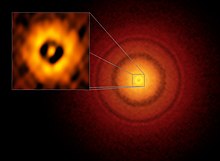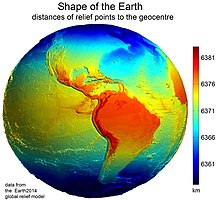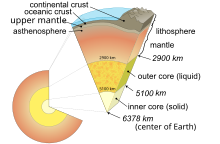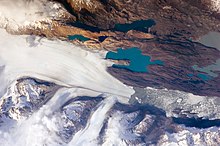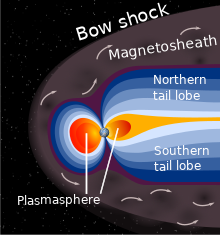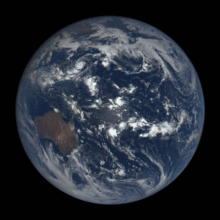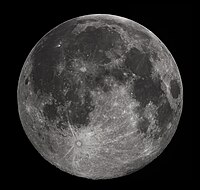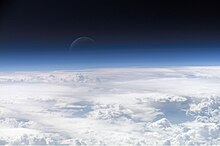Home » Archives for 04/17/22
রবিবার, ১৭ এপ্রিল, ২০২২
Earth
Earth
Jump to navigationJump to search
Etymology
Chronology
Formation
Geological history
Origin of life and evolution
| ||||||||||||||||||||||||||||||||||||||||||||
Future
Physical characteristics
Size and shape
Internal structure
| Illustration of Earth's cutaway, not to scale | ||
|---|---|---|
| Depth[95] | Component | Density |
| 0–60 | Lithosphere[n 7] | — |
| 0–35 | Crust[n 8] | 2.2–2.9 |
| 35–660 | Upper mantle | 3.4–4.4 |
| 660-2890 | Lower mantle | 3.4–5.6 |
| 100–700 | Asthenosphere | — |
| 2890–5100 | Outer core | 9.9–12.2 |
| 5100–6378 | Inner core | 12.8–13.1 |
Chemical composition
Heat
| Isotope | Concentration | Heat release in gigawatts |
|---|---|---|
| 232Th | 0.0000124% | 13113 |
| 238U | 0.00000308% | 11669 |
| 40K | 0.00000369% | 4331 |
| 235U | 0.000000022% | 501 |
Tectonic plates
Surface
Gravitational field
Magnetic field
Orbit and rotation
Rotation
Orbit
Axial tilt and seasons
Earth-Moon system
Moon
| Diameter | 3,474.8 km |
| Mass | 7.349×1022 kg |
| Semi-major axis | 384,400 km |
| Orbital period | 27d 7h 43.7m |
Asteroids and artificial satellites
Hydrosphere
Atmosphere
Weather and climate
Upper atmosphere
Life on Earth
Human geography
Natural resources and land use
| Land use | Percentage |
|---|---|
| Cropland | 12–14% |
| Pastures | 30–47% |
| Human-used forests | 16–27% |
| Infrastructure | 1% |
| Unused land | 24–31% |
Humans and environment
Cultural and historical viewpoint
See also
Notes
- ^ All astronomical quantities vary, both secularly and periodically. The quantities given are the values at the instant J2000.0 of the secular variation, ignoring all periodic variations.
- ^ Jump up to:a b aphelion = a × (1 + e); perihelion = a × (1 – e), where a is the semi-major axis and e is the eccentricity. The difference between Earth's perihelion and aphelion is 5 million kilometers.—Wilkinson, John (2009). Probing the New Solar System. CSIRO Publishing. p. 144. ISBN 978-0-643-09949-4.
- ^ Jump up to:a b As of 4 January 2018, the United States Strategic Command tracked a total of 18,835 artificial objects, mostly debris. See: Anz-Meador, Phillip; Shoots, Debi, eds. (February 2018). "Satellite Box Score" (PDF). Orbital Debris Quarterly News. 22 (1): 12. Retrieved 18 April 2018.
- ^ Earth's circumference is almost exactly 40,000 km because the meter was calibrated on this measurement—more specifically, 1/10-millionth of the distance between the poles and the equator.
- ^ Due to natural fluctuations, ambiguities surrounding ice shelves, and mapping conventions for vertical datums, exact values for land and ocean coverage are not meaningful. Based on data from the Vector Map and Global Landcover Archived 26 March 2015 at the Wayback Machine datasets, extreme values for coverage of lakes and streams are 0.6% and 1.0% of Earth's surface. The ice sheets of Antarctica and Greenland are counted as land, even though much of the rock that supports them lies below sea level.
- ^ If Earth were shrunk to the size of a billiard ball, some areas of Earth such as large mountain ranges and oceanic trenches would feel like tiny imperfections, whereas much of the planet, including the Great Plains and the abyssal plains, would feel smoother.[88]
- ^ Locally varies between 5 and 200 km.
- ^ Locally varies between 5 and 70 km.
- ^ Including the Somali Plate, which is being formed out of the African Plate. See: Chorowicz, Jean (October 2005). "The East African rift system". Journal of African Earth Sciences. 43 (1–3): 379–410. Bibcode:2005JAfES..43..379C. doi:10.1016/j.jafrearsci.2005.07.019.
- ^ The ultimate source of these figures, uses the term "seconds of UT1" instead of "seconds of mean solar time".—Aoki, S.; Kinoshita, H.; Guinot, B.; Kaplan, G. H.; McCarthy, D. D.; Seidelmann, P. K. (1982). "The new definition of universal time". Astronomy and Astrophysics. 105 (2): 359–61. Bibcode:1982A&A...105..359A.
- ^ For Earth, the Hill radius is
, where m is the mass of Earth, a is an astronomical unit, and M is the mass of the Sun. So the radius in AU is about
.
- ^ Aphelion is 103.4% of the distance to perihelion. Due to the inverse square law, the radiation at perihelion is about 106.9% of the energy at aphelion.
References
- ^ Petsko, Gregory A. (28 April 2011). "The blue marble". Genome Biology. 12 (4): 112. doi:10.1186/gb-2011-12-4-112. PMC 3218853. PMID 21554751.
- ^ "Apollo Imagery – AS17-148-22727". NASA. 1 November 2012. Archived from the original on 20 April 2019. Retrieved 22 October 2020.
- ^ Jump up to:a b Simon, J.L.; et al. (February 1994). "Numerical expressions for precession formulae and mean elements for the Moon and planets". Astronomy and Astrophysics. 282 (2): 663–83. Bibcode:1994A&A...282..663S.
- ^ Jump up to:a b c d e Staff (7 August 2007). "Useful Constants". International Earth Rotation and Reference Systems Service. Retrieved 23 September 2008.
- ^ Jump up to:a b c d e f g h i j k l m n Williams, David R. (16 March 2017). "Earth Fact Sheet". NASA/Goddard Space Flight Center. Retrieved 26 July 2018.
- ^ Allen, Clabon Walter; Cox, Arthur N. (2000). Allen's Astrophysical Quantities. Springer. p. 294. ISBN 978-0-387-98746-0. Retrieved 13 March 2011.
- ^ "HORIZONS Batch call for 2022 perihelion". ssd.jpl.nasa.gov. NASA/JPL. Retrieved 7 September 2021.
- ^ Jump up to:a b "UCS Satellite Database". Nuclear Weapons & Global Security. Union of Concerned Scientists. 1 September 2021. Retrieved 12 January 2022.
- ^ Various (2000). David R. Lide (ed.). Handbook of Chemistry and Physics (81st ed.). CRC Press. ISBN 978-0-8493-0481-1.
- ^ "Selected Astronomical Constants, 2011". The Astronomical Almanac. Archived from the original on 26 August 2013. Retrieved 25 February 2011.
- ^ Jump up to:a b World Geodetic System (WGS-84). Available online Archived 11 March 2020 at the Wayback Machine from National Geospatial-Intelligence Agency.
- ^ Cazenave, Anny (1995). "Geoid, Topography and Distribution of Landforms" (PDF). In Ahrens, Thomas J (ed.). Global Earth Physics: A Handbook of Physical Constants. Global Earth Physics: A Handbook of Physical Constants. Washington, DC: American Geophysical Union. Bibcode:1995geph.conf.....A. ISBN 978-0-87590-851-9. Archived from the original (PDF) on 16 October 2006. Retrieved 3 August 2008.
- ^ International Earth Rotation and Reference Systems Service (IERS) Working Group (2004). "General Definitions and Numerical Standards" (PDF). In McCarthy, Dennis D.; Petit, Gérard (eds.). IERS Conventions (2003) (PDF). IERS Technical Note No. 32. Frankfurt am Main: Verlag des Bundesamts für Kartographie und Geodäsie. p. 12. ISBN 978-3-89888-884-4. Retrieved 29 April 2016.
- ^ Humerfelt, Sigurd (26 October 2010). "How WGS 84 defines Earth". Home Online. Archived from the original on 24 April 2011. Retrieved 29 April 2011.
- ^ Jump up to:a b c Pidwirny, Michael (2 February 2006). "Surface area of our planet covered by oceans and continents.(Table 8o-1)". University of British Columbia, Okanagan. Retrieved 26 November 2007.
- ^ Luzum, Brian; Capitaine, Nicole; Fienga, Agnès; Folkner, William; Fukushima, Toshio; et al. (August 2011). "The IAU 2009 system of astronomical constants: The report of the IAU working group on numerical standards for Fundamental Astronomy". Celestial Mechanics and Dynamical Astronomy. 110 (4): 293–304. Bibcode:2011CeMDA.110..293L. doi:10.1007/s10569-011-9352-4.
- ^ The international system of units (SI) (PDF) (2008 ed.). United States Department of Commerce, NIST Special Publication 330. p. 52. Archived from the original (PDF) on 5 February 2009.
- ^ Williams, James G. (1994). "Contributions to the Earth's obliquity rate, precession, and nutation". The Astronomical Journal. 108: 711. Bibcode:1994AJ....108..711W. doi:10.1086/117108. ISSN 0004-6256.
- ^ Allen, Clabon Walter; Cox, Arthur N. (2000). Allen's Astrophysical Quantities. Springer. p. 296. ISBN 978-0-387-98746-0. Retrieved 17 August 2010.
- ^ Arthur N. Cox, ed. (2000). Allen's Astrophysical Quantities (4th ed.). New York: AIP Press. p. 244. ISBN 978-0-387-98746-0. Retrieved 17 August 2010.
- ^ "World: Lowest Temperature". WMO Weather and Climate Extremes Archive. Arizona State University. Retrieved 6 September 2020.
- ^ Jones, P. D.; Harpham, C. (2013). "Estimation of the absolute surface air temperature of the Earth". Journal of Geophysical Research: Atmospheres. 118 (8): 3213–3217. Bibcode:2013JGRD..118.3213J. doi:10.1002/jgrd.50359. ISSN 2169-8996.
- ^ "World: Highest Temperature". WMO Weather and Climate Extremes Archive. Arizona State University. Retrieved 6 September 2020.
- ^ United Nations Scientific Committee on the Effects of Atomic Radiation (2008). Sources and effects of ionizing radiation. New York: United Nations (published 2010). Table 1. ISBN 978-92-1-142274-0. Retrieved 9 November 2012.
- ^ "Trends in Atmospheric Carbon Dioxide: Recent Global CO2 Trend". Earth System Research Laboratory. National Oceanic and Atmospheric Administration. 19 October 2020. Archived from the original on 4 October 2020.
- ^ Jump up to:a b "earth, n.¹". Oxford English Dictionary (3 ed.). Oxford, England: Oxford University Press. 2010. doi:10.1093/acref/9780199571123.001.0001. ISBN 978-0-19-957112-3.
- ^ Simek, Rudolf. Trans. Angela Hall as Dictionary of Northern Mythology, p. 179. D.S. Brewer, 2007. ISBN 978-0-85991-513-7.
- ^ The New Oxford Dictionary of English, 1st ed. "earth". Oxford University Press (Oxford), 1998. ISBN 978-0-19-861263-6.
- ^ "Terra". Oxford English Dictionary (Online ed.). Oxford University Press. (Subscription or participating institution membership required.)
- ^ "Tellus". Oxford English Dictionary (Online ed.). Oxford University Press. (Subscription or participating institution membership required.)
- ^ "Gaia". Oxford English Dictionary (Online ed.). Oxford University Press. (Subscription or participating institution membership required.)
- ^ "Terran". Oxford English Dictionary (Online ed.). Oxford University Press. (Subscription or participating institution membership required.)
- ^ "terrestrial". Oxford English Dictionary (Online ed.). Oxford University Press. (Subscription or participating institution membership required.)
- ^ "terrene". Oxford English Dictionary (Online ed.). Oxford University Press. (Subscription or participating institution membership required.)
- ^ "tellurian". Oxford English Dictionary (Online ed.). Oxford University Press. (Subscription or participating institution membership required.)
- ^ "Telluric". Lexico. Oxford English Dictionary. Retrieved 7 November 2020.
- ^ Bouvier, Audrey; Wadhwa, Meenakshi (September 2010). "The age of the Solar System redefined by the oldest Pb–Pb age of a meteoritic inclusion". Nature Geoscience. 3 (9): 637–41. Bibcode:2010NatGe...3..637B. doi:10.1038/ngeo941.
- ^ See:
- Dalrymple, G. Brent (1991). The Age of the Earth. California: Stanford University Press. ISBN 978-0-8047-1569-0.
- Newman, William L. (9 July 2007). "Age of the Earth". Publications Services, USGS. Retrieved 20 September 2007.
- Dalrymple, G. Brent (2001). "The age of the Earth in the twentieth century: a problem (mostly) solved". Geological Society, London, Special Publications. 190 (1): 205–21. Bibcode:2001GSLSP.190..205D. doi:10.1144/GSL.SP.2001.190.01.14. S2CID 130092094. Retrieved 20 September 2007.
- ^ Righter, K.; Schonbachler, M. (7 May 2018). "Ag Isotopic Evolution of the Mantle During Accretion: New Constraints from Pd and Ag Metal-Silicate Partitioning". Differentiation: Building the Internal Architecture of Planets. 2084: 4034. Bibcode:2018LPICo2084.4034R. Retrieved 25 October 2020.
- ^ Tartèse, Romain; Anand, Mahesh; Gattacceca, Jérôme; Joy, Katherine H.; Mortimer, James I.; Pernet-Fisher, John F.; Russell, Sara; Snape, Joshua F.; Weiss, Benjamin P. (2019). "Constraining the Evolutionary History of the Moon and the Inner Solar System: A Case for New Returned Lunar Samples". Space Science Reviews. 215 (8): 54. Bibcode:2019SSRv..215...54T. doi:10.1007/s11214-019-0622-x. ISSN 1572-9672.
- ^ Reilly, Michael (22 October 2009). "Controversial Moon Origin Theory Rewrites History". Discovery News. Archived from the original on 9 January 2010. Retrieved 30 January 2010.
- ^ Jump up to:a b Canup, R.; Asphaug, E. I. (2001). "Origin of the Moon in a giant impact near the end of the Earth's formation". Nature. 412 (6848): 708–12. Bibcode:2001Natur.412..708C. doi:10.1038/35089010. PMID 11507633. S2CID 4413525.
- ^ Meier, M. M. M.; Reufer, A.; Wieler, R. (4 August 2014). "On the origin and composition of Theia: Constraints from new models of the Giant Impact" (PDF). Icarus. 242: 5. arXiv:1410.3819. Bibcode:2014Icar..242..316M. doi:10.1016/j.icarus.2014.08.003. S2CID 119226112. Retrieved 25 October 2020.
- ^ Claeys, Philippe; Morbidelli, Alessandro (2011). "Late Heavy Bombardment". In Gargaud, Muriel; Amils, Prof Ricardo; Quintanilla, José Cernicharo; Cleaves II, Henderson James (Jim); Irvine, William M.; Pinti, Prof Daniele L.; Viso, Michel (eds.). Encyclopedia of Astrobiology. Springer Berlin Heidelberg. pp. 909–12. doi:10.1007/978-3-642-11274-4_869. ISBN 978-3-642-11271-3.
- ^ "Earth's Early Atmosphere and Oceans". Lunar and Planetary Institute. Universities Space Research Association. Retrieved 27 June 2019.
- ^ Morbidelli, A.; et al. (2000). "Source regions and time scales for the delivery of water to Earth". Meteoritics & Planetary Science. 35 (6): 1309–20. Bibcode:2000M&PS...35.1309M. doi:10.1111/j.1945-5100.2000.tb01518.x.
- ^ Piani, Laurette; Marrocchi, Yves; Rigaudier, Thomas; Vacher, Lionel G.; Thomassin, Dorian; Marty, Bernard (2020). "Earth's water may have been inherited from material similar to enstatite chondrite meteorites". Science. 369 (6507): 1110–13. Bibcode:2020Sci...369.1110P. doi:10.1126/science.aba1948. ISSN 0036-8075. PMID 32855337. S2CID 221342529.
- ^ Guinan, E. F.; Ribas, I. (2002). Benjamin Montesinos, Alvaro Gimenez and Edward F. Guinan (ed.). Our Changing Sun: The Role of Solar Nuclear Evolution and Magnetic Activity on Earth's Atmosphere and Climate. ASP Conference Proceedings: The Evolving Sun and its Influence on Planetary Environments. San Francisco: Astronomical Society of the Pacific. Bibcode:2002ASPC..269...85G. ISBN 978-1-58381-109-2.
- ^ Staff (4 March 2010). "Oldest measurement of Earth's magnetic field reveals battle between Sun and Earth for our atmosphere". Phys.org. Retrieved 27 March 2010.
- ^ Jump up to:a b Harrison, T.; et al. (December 2005). "Heterogeneous Hadean hafnium: evidence of continental crust at 4.4 to 4.5 ga". Science. 310 (5756): 1947–50. Bibcode:2005Sci...310.1947H. doi:10.1126/science.1117926. PMID 16293721. S2CID 11208727.
- ^ Rogers, John James William; Santosh, M. (2004). Continents and Supercontinents. Oxford University Press US. p. 48. ISBN 978-0-19-516589-0.
- ^ Hurley, P. M.; Rand, J. R. (June 1969). "Pre-drift continental nuclei". Science. 164 (3885): 1229–42. Bibcode:1969Sci...164.1229H. doi:10.1126/science.164.3885.1229. PMID 17772560.
- ^ Armstrong, R. L. (1991). "The persistent myth of crustal growth" (PDF). Australian Journal of Earth Sciences. 38 (5): 613–30. Bibcode:1991AuJES..38..613A. CiteSeerX 10.1.1.527.9577. doi:10.1080/08120099108727995.
- ^ De Smet, J.; Van Den Berg, A.P.; Vlaar, N.J. (2000). "Early formation and long-term stability of continents resulting from decompression melting in a convecting mantle" (PDF). Tectonophysics. 322 (1–2): 19–33. Bibcode:2000Tectp.322...19D. doi:10.1016/S0040-1951(00)00055-X. hdl:1874/1653.
- ^ Dhuime, B.; Hawksworth, C.J.; Delavault, H.; Cawood, P.A. (2018). "Rates of generation and destruction of the continental crust: implications for continental growth". Philosophical Transactions A. 376 (2132). Bibcode:2018RSPTA.37670403D. doi:10.1098/rsta.2017.0403. PMC 6189557. PMID 30275156.
- ^ Bradley, D.C. (2011). "Secular Trends in the Geologic Record and the Supercontinent Cycle". Earth-Science Reviews. 108 (1–2): 16–33. Bibcode:2011ESRv..108...16B. CiteSeerX 10.1.1.715.6618. doi:10.1016/j.earscirev.2011.05.003.
- ^ Kinzler, Ro. "When and how did the ice age end? Could another one start?". American Museum of Natural History. Retrieved 27 June 2019.
- ^ Chalk, Thomas B.; Hain, Mathis P.; Foster, Gavin L.; Rohling, Eelco J.; Sexton, Philip F.; Badger, Marcus P. S.; Cherry, Soraya G.; Hasenfratz, Adam P.; Haug, Gerald H.; Jaccard, Samuel L.; Martínez-García, Alfredo; Pälike, Heiko; Pancost, Richard D.; Wilson, Paul A. (12 December 2007). "Causes of ice age intensification across the Mid-Pleistocene Transition" (PDF). Proc Natl Acad Sci U S A. 114 (50): 13114–19. doi:10.1073/pnas.1702143114. PMC 5740680. PMID 29180424. Retrieved 28 June 2019.
- ^ Staff. "Paleoclimatology – The Study of Ancient Climates". Page Paleontology Science Center. Archived from the original on 4 March 2007. Retrieved 2 March 2007.
- ^ Turner, Chris S.M.; et al. (2010). "The potential of New Zealand kauri (Agathis australis) for testing the synchronicity of abrupt climate change during the Last Glacial Interval (60,000–11,700 years ago)". Quaternary Science Reviews. Elsevier. 29 (27–28): 3677–3682. Bibcode:2010QSRv...29.3677T. doi:10.1016/j.quascirev.2010.08.017. Retrieved 3 November 2020.
- ^ Doolittle, W. Ford; Worm, Boris (February 2000). "Uprooting the tree of life" (PDF). Scientific American. 282 (6): 90–95. Bibcode:2000SciAm.282b..90D. doi:10.1038/scientificamerican0200-90. PMID 10710791. Archived from the original (PDF) on 15 July 2011.
- ^ Jump up to:a b Zimmer, Carl (3 October 2013). "Earth's Oxygen: A Mystery Easy to Take for Granted". The New York Times. Archived from the original on 3 October 2013. Retrieved 3 October 2013.
- ^ Berkner, L. V.; Marshall, L. C. (1965). "On the Origin and Rise of Oxygen Concentration in the Earth's Atmosphere". Journal of the Atmospheric Sciences. 22 (3): 225–61. Bibcode:1965JAtS...22..225B. doi:10.1175/1520-0469(1965)022<0225:OTOARO>2.0.CO;2.
- ^ Burton, Kathleen (29 November 2002). "Astrobiologists Find Evidence of Early Life on Land". NASA. Retrieved 5 March 2007.
- ^ Noffke, Nora; Christian, Daniel; Wacey, David; Hazen, Robert M. (8 November 2013). "Microbially Induced Sedimentary Structures Recording an Ancient Ecosystem in the ca. 3.48 Billion-Year-Old Dresser Formation, Pilbara, Western Australia". Astrobiology. 13 (12): 1103–24. Bibcode:2013AsBio..13.1103N. doi:10.1089/ast.2013.1030. PMC 3870916. PMID 24205812.
- ^ Ohtomo, Yoko; Kakegawa, Takeshi; Ishida, Akizumi; et al. (January 2014). "Evidence for biogenic graphite in early Archaean Isua metasedimentary rocks". Nature Geoscience. 7 (1): 25–28. Bibcode:2014NatGe...7...25O. doi:10.1038/ngeo2025. ISSN 1752-0894. S2CID 54767854.
- ^ Borenstein, Seth (19 October 2015). "Hints of life on what was thought to be desolate early Earth". Excite. Yonkers, NY: Mindspark Interactive Network. Associated Press. Archived from the original on 18 August 2016. Retrieved 20 October 2015.
- ^ Bell, Elizabeth A.; Boehnike, Patrick; Harrison, T. Mark; et al. (19 October 2015). "Potentially biogenic carbon preserved in a 4.1 billion-year-old zircon" (PDF). Proc. Natl. Acad. Sci. U.S.A. 112 (47): 14518–21. Bibcode:2015PNAS..11214518B. doi:10.1073/pnas.1517557112. ISSN 1091-6490. PMC 4664351. PMID 26483481. Retrieved 20 October 2015. Early edition, published online before print.
- ^ Tyrell, Kelly April (18 December 2017). "Oldest fossils ever found show life on Earth began before 3.5 billion years ago". University of Wisconsin–Madison. Retrieved 18 December 2017.
- ^ Schopf, J. William; Kitajima, Kouki; Spicuzza, Michael J.; Kudryavtsev, Anatolly B.; Valley, John W. (2017). "SIMS analyses of the oldest known assemblage of microfossils document their taxon-correlated carbon isotope compositions". PNAS. 115 (1): 53–58. Bibcode:2018PNAS..115...53S. doi:10.1073/pnas.1718063115. PMC 5776830. PMID 29255053.
- ^ Brooke, John L. (2014). Climate Change and the Course of Global History. Cambridge University Press. p. 42. ISBN 978-0-521-87164-8.
- ^ Cabej, Nelson R. (2019). Epigenetic Mechanisms of the Cambrian Explosion. Elsevier Science. p. 56. ISBN 978-0-12-814312-4.
- ^ Raup, D. M.; Sepkoski Jr, J. J. (1982). "Mass Extinctions in the Marine Fossil Record". Science. 215 (4539): 1501–03. Bibcode:1982Sci...215.1501R. doi:10.1126/science.215.4539.1501. PMID 17788674. S2CID 43002817.
- ^ Stanley, S. M. (2016). "Estimates of the magnitudes of major marine mass extinctions in earth history". Proceedings of the National Academy of Sciences of the United States of America. 113 (42): E6325–34. Bibcode:2016PNAS..113E6325S. doi:10.1073/pnas.1613094113. PMC 5081622. PMID 27698119. S2CID 23599425.
- ^ Gould, Stephan J. (October 1994). "The Evolution of Life on Earth". Scientific American. 271 (4): 84–91. Bibcode:1994SciAm.271d..84G. doi:10.1038/scientificamerican1094-84. PMID 7939569. Retrieved 5 March 2007.
- ^ Wilkinson, B. H.; McElroy, B. J. (2007). "The impact of humans on continental erosion and sedimentation". Bulletin of the Geological Society of America. 119 (1–2): 140–56. Bibcode:2007GSAB..119..140W. doi:10.1130/B25899.1. S2CID 128776283.
- ^ Ganopolski, A.; Winkelmann, R.; Schellnhuber, H. J. (2016). "Critical insolation – CO2 relation for diagnosing past and future glacial inception". Nature. 529 (7585): 200–03. Bibcode:2016Natur.529..200G. doi:10.1038/nature16494. ISSN 1476-4687. PMID 26762457. S2CID 4466220.
- ^ Jump up to:a b c Sackmann, I.-J.; Boothroyd, A. I.; Kraemer, K. E. (1993). "Our Sun. III. Present and Future". Astrophysical Journal. 418: 457–68. Bibcode:1993ApJ...418..457S. doi:10.1086/173407.
- ^ Britt, Robert (25 February 2000). "Freeze, Fry or Dry: How Long Has the Earth Got?". Space.com. Archived from the original on 5 June 2009.
- ^ Li, King-Fai; Pahlevan, Kaveh; Kirschvink, Joseph L.; Yung, Yuk L. (2009). "Atmospheric pressure as a natural climate regulator for a terrestrial planet with a biosphere" (PDF). Proceedings of the National Academy of Sciences. 106 (24): 9576–79. Bibcode:2009PNAS..106.9576L. doi:10.1073/pnas.0809436106. PMC 2701016. PMID 19487662. Retrieved 19 July 2009.
- ^ Ward, Peter D.; Brownlee, Donald (2002). The Life and Death of Planet Earth: How the New Science of Astrobiology Charts the Ultimate Fate of Our World. New York: Times Books, Henry Holt and Company. ISBN 978-0-8050-6781-1.
- ^ Jump up to:a b Mello, Fernando de Sousa; Friaça, Amâncio César Santos (2020). "The end of life on Earth is not the end of the world: converging to an estimate of life span of the biosphere?". International Journal of Astrobiology. 19 (1): 25–42. Bibcode:2020IJAsB..19...25D. doi:10.1017/S1473550419000120. ISSN 1473-5504.
- ^ Bounama, Christine; Franck, S.; Von Bloh, W. (2001). "The fate of Earth's ocean". Hydrology and Earth System Sciences. 5 (4): 569–75. Bibcode:2001HESS....5..569B. doi:10.5194/hess-5-569-2001. S2CID 14024675.
- ^ Schröder, K.-P.; Connon Smith, Robert (2008). "Distant future of the Sun and Earth revisited". Monthly Notices of the Royal Astronomical Society. 386 (1): 155–63. arXiv:0801.4031. Bibcode:2008MNRAS.386..155S. doi:10.1111/j.1365-2966.2008.13022.x. S2CID 10073988.
See also Palmer, Jason (22 February 2008). "Hope dims that Earth will survive Sun's death". NewScientist.com news service. Archived from the original on 15 April 2012. Retrieved 24 March 2008. - ^ Milbert, D. G.; Smith, D. A. "Converting GPS Height into NAVD88 Elevation with the GEOID96 Geoid Height Model". National Geodetic Survey, NOAA. Retrieved 7 March 2007.
- ^ Jump up to:a b Sandwell, D. T.; Smith, Walter H. F. (7 July 2006). "Exploring the Ocean Basins with Satellite Altimeter Data". NOAA/NGDC. Archived from the original on 15 July 2014. Retrieved 21 April 2007.
- ^ Stewart, Heather A.; Jamieson, Alan J. (2019). "The five deeps: The location and depth of the deepest place in each of the world's oceans". Earth-Science Reviews. 197: 102896. Bibcode:2019ESRv..19702896S. doi:10.1016/j.earscirev.2019.102896. ISSN 0012-8252.
- ^ "Is a Pool Ball Smoother than the Earth?" (PDF). Billiards Digest. 1 June 2013. Retrieved 26 November 2014.
- ^ Tewksbury, Barbara. "Back-of-the-Envelope Calculations: Scale of the Himalayas". Carleton University. Retrieved 19 October 2020.
- ^ Senne, Joseph H. (2000). "Did Edmund Hillary Climb the Wrong Mountain". Professional Surveyor. 20 (5): 16–21.
- ^ Sharp, David (5 March 2005). "Chimborazo and the old kilogram". The Lancet. 365 (9462): 831–32. doi:10.1016/S0140-6736(05)71021-7. PMID 15752514. S2CID 41080944.
- ^ Krulwich, Robert (7 April 2007). "The 'Highest' Spot on Earth". NPR. Retrieved 31 July 2012.
- ^ "What is the geoid?". National Ocean Service. Retrieved 10 October 2020.
- ^ Jordan, T. H. (1979). "Structural geology of the Earth's interior". Proceedings of the National Academy of Sciences of the United States of America. 76 (9): 4192–4200. Bibcode:1979PNAS...76.4192J. doi:10.1073/pnas.76.9.4192. PMC 411539. PMID 16592703.
- ^ Robertson, Eugene C. (26 July 2001). "The Interior of the Earth". USGS. Retrieved 24 March 2007.
- ^ "The Crust and Lithosphere". London Geological Society. 2012. Retrieved 25 October 2020.
- ^ Micalizio, Caryl-Sue; Evers, Jeannie (20 May 2015). "Lithosphere". National Geographic. Retrieved 13 October 2020.
- ^ Tanimoto, Toshiro (1995). "Crustal Structure of the Earth" (PDF). In Thomas J. Ahrens (ed.). Global Earth Physics: A Handbook of Physical Constants. Global Earth Physics: A Handbook of Physical Constants. Washington, DC: American Geophysical Union. Bibcode:1995geph.conf.....A. ISBN 978-0-87590-851-9. Archived from the original (PDF) on 16 October 2006. Retrieved 3 February 2007.
- ^ Deuss, Arwen (2014). "Heterogeneity and Anisotropy of Earth's Inner Core" (PDF). Annu. Rev. Earth Planet. Sci. 42 (1): 103–26. Bibcode:2014AREPS..42..103D. doi:10.1146/annurev-earth-060313-054658.
- ^ Jump up to:a b Morgan, J. W.; Anders, E. (1980). "Chemical composition of Earth, Venus, and Mercury". Proceedings of the National Academy of Sciences. 77 (12): 6973–77. Bibcode:1980PNAS...77.6973M. doi:10.1073/pnas.77.12.6973. PMC 350422. PMID 16592930.
- ^ Brown, Geoff C.; Mussett, Alan E. (1981). The Inaccessible Earth (2nd ed.). Taylor & Francis. p. 166. ISBN 978-0-04-550028-4. Note: After Ronov and Yaroshevsky (1969).
- ^ Jump up to:a b Turcotte, D. L.; Schubert, G. (2002). "4". Geodynamics (2 ed.). Cambridge, England: Cambridge University Press. p. 137. ISBN 978-0-521-66624-4.
- ^ Sanders, Robert (10 December 2003). "Radioactive potassium may be major heat source in Earth's core". UC Berkeley News. Retrieved 28 February 2007.
- ^ "The Earth's Centre is 1000 Degrees Hotter than Previously Thought". The European Synchrotron (ESRF). 25 April 2013. Archived from the original on 28 June 2013. Retrieved 12 April 2015.
- ^ Alfè, D.; Gillan, M. J.; Vočadlo, L.; Brodholt, J.; Price, G. D. (2002). "The ab initio simulation of the Earth's core" (PDF). Philosophical Transactions of the Royal Society. 360 (1795): 1227–44. Bibcode:2002RSPTA.360.1227A. doi:10.1098/rsta.2002.0992. PMID 12804276. S2CID 21132433. Retrieved 28 February 2007.
- ^ Vlaar, N; Vankeken, P.; Vandenberg, A. (1994). "Cooling of the Earth in the Archaean: Consequences of pressure-release melting in a hotter mantle" (PDF). Earth and Planetary Science Letters. 121 (1–2): 1–18. Bibcode:1994E&PSL.121....1V. doi:10.1016/0012-821X(94)90028-0. Archived from the original (PDF) on 19 March 2012.
- ^ Pollack, Henry N.; Hurter, Suzanne J.; Johnson, Jeffrey R. (August 1993). "Heat flow from the Earth's interior: Analysis of the global data set". Reviews of Geophysics. 31 (3): 267–80. Bibcode:1993RvGeo..31..267P. doi:10.1029/93RG01249.
- ^ Richards, M. A.; Duncan, R. A.; Courtillot, V. E. (1989). "Flood Basalts and Hot-Spot Tracks: Plume Heads and Tails". Science. 246 (4926): 103–07. Bibcode:1989Sci...246..103R. doi:10.1126/science.246.4926.103. PMID 17837768. S2CID 9147772.
- ^ Sclater, John G; Parsons, Barry; Jaupart, Claude (1981). "Oceans and Continents: Similarities and Differences in the Mechanisms of Heat Loss". Journal of Geophysical Research. 86 (B12): 11535. Bibcode:1981JGR....8611535S. doi:10.1029/JB086iB12p11535.
- ^ Brown, W. K.; Wohletz, K. H. (2005). "SFT and the Earth's Tectonic Plates". Los Alamos National Laboratory. Retrieved 2 March 2007.
- ^ Kious, W. J.; Tilling, R. I. (5 May 1999). "Understanding plate motions". USGS. Retrieved 2 March 2007.
- ^ Seligman, Courtney (2008). "The Structure of the Terrestrial Planets". Online Astronomy eText Table of Contents. cseligman.com. Retrieved 28 February 2008.
- ^ Duennebier, Fred (12 August 1999). "Pacific Plate Motion". University of Hawaii. Retrieved 14 March 2007.
- ^ Mueller, R. D.; et al. (7 March 2007). "Age of the Ocean Floor Poster". NOAA. Retrieved 14 March 2007.
- ^ Bowring, Samuel A.; Williams, Ian S. (1999). "Priscoan (4.00–4.03 Ga) orthogneisses from northwestern Canada". Contributions to Mineralogy and Petrology. 134 (1): 3–16. Bibcode:1999CoMP..134....3B. doi:10.1007/s004100050465. S2CID 128376754.
- ^ Meschede, Martin; Barckhausen, Udo (20 November 2000). "Plate Tectonic Evolution of the Cocos-Nazca Spreading Center". Proceedings of the Ocean Drilling Program. Texas A&M University. Retrieved 2 April 2007.
- ^ Argus, D.F.; Gordon, R.G.; DeMets, C. (2011). "Geologically current motion of 56 plates relative to the no‐net‐rotation reference frame". Geochemistry, Geophysics, Geosystems. 12 (11): n/a. Bibcode:2011GGG....1211001A. doi:10.1029/2011GC003751.
- ^ "World Factbook". Cia.gov. Retrieved 2 November 2012.
- ^ Center, National Geophysical Data. "Hypsographic Curve of Earth's Surface from ETOPO1". ngdc.noaa.gov.
- ^ Staff. "Layers of the Earth". Volcano World. Oregon State University. Archived from the original on 11 February 2013. Retrieved 11 March 2007.
- ^ Jessey, David. "Weathering and Sedimentary Rocks". California State Polytechnic University, Pomona. Archived from the original on 3 July 2007. Retrieved 20 March 2007.
- ^ de Pater, Imke; Lissauer, Jack J. (2010). Planetary Sciences (2nd ed.). Cambridge University Press. p. 154. ISBN 978-0-521-85371-2.
- ^ Wenk, Hans-Rudolf; Bulakh, Andreĭ Glebovich (2004). Minerals: their constitution and origin. Cambridge University Press. p. 359. ISBN 978-0-521-52958-7.
- ^ Kring, David A. "Terrestrial Impact Cratering and Its Environmental Effects". Lunar and Planetary Laboratory. Retrieved 22 March 2007.
- ^ Martin, Ronald (2011). Earth's Evolving Systems: The History of Planet Earth. Jones & Bartlett Learning. ISBN 978-0-7637-8001-2. OCLC 635476788.
- ^ "World Bank arable land". World Bank. Retrieved 19 October 2015.
- ^ "World Bank permanent cropland". World Bank. Retrieved 19 October 2015.
- ^ Hooke, Roger LeB.; Martín-Duque, José F.; Pedraza, Javier (December 2012). "Land transformation by humans: A review" (PDF). GSA Today. 22 (12): 4–10. doi:10.1130/GSAT151A.1.
- ^ Watts, A. B.; Daly, S. F. (May 1981). "Long wavelength gravity and topography anomalies". Annual Review of Earth and Planetary Sciences. 9: 415–18. Bibcode:1981AREPS...9..415W. doi:10.1146/annurev.ea.09.050181.002215.
- ^ Olson, Peter; Amit, Hagay (2006). "Changes in earth's dipole" (PDF). Naturwissenschaften. 93 (11): 519–42. Bibcode:2006NW.....93..519O. doi:10.1007/s00114-006-0138-6. PMID 16915369. S2CID 22283432.
- ^ Fitzpatrick, Richard (16 February 2006). "MHD dynamo theory". NASA WMAP. Retrieved 27 February 2007.
- ^ Campbell, Wallace Hall (2003). Introduction to Geomagnetic Fields. New York: Cambridge University Press. p. 57. ISBN 978-0-521-82206-0.
- ^ Ganushkina, N. Yu; Liemohn, M. W.; Dubyagin, S. (2018). "Current Systems in the Earth's Magnetosphere". Reviews of Geophysics. 56 (2): 309–32. Bibcode:2018RvGeo..56..309G. doi:10.1002/2017RG000590. hdl:2027.42/145256. ISSN 1944-9208. S2CID 134666611.
- ^ Masson, Arnaud (11 May 2007). "Cluster reveals the reformation of the Earth's bow shock". European Space Agency. Retrieved 16 August 2016.
- ^ Gallagher, Dennis L. (14 August 2015). "The Earth's Plasmasphere". NASA/Marshall Space Flight Center. Retrieved 16 August 2016.
- ^ Gallagher, Dennis L. (27 May 2015). "How the Plasmasphere is Formed". NASA/Marshall Space Flight Center. Retrieved 16 August 2016.
- ^ Baumjohann, Wolfgang; Treumann, Rudolf A. (1997). Basic Space Plasma Physics. World Scientific. pp. 8, 31. ISBN 978-1-86094-079-8.
- ^ McElroy, Michael B. (2012). "Ionosphere and magnetosphere". Encyclopædia Britannica. Encyclopædia Britannica, Inc.
- ^ Van Allen, James Alfred (2004). Origins of Magnetospheric Physics. University of Iowa Press. ISBN 978-0-87745-921-7. OCLC 646887856.
- ^ Stern, David P. (8 July 2005). "Exploration of the Earth's Magnetosphere". NASA. Retrieved 21 March 2007.
- ^ McCarthy, Dennis D.; Hackman, Christine; Nelson, Robert A. (November 2008). "The Physical Basis of the Leap Second" (PDF). The Astronomical Journal. 136 (5): 1906–08. Bibcode:2008AJ....136.1906M. doi:10.1088/0004-6256/136/5/1906. Archived from the original (PDF) on 28 July 2018.
- ^ "Leap seconds". Time Service Department, USNO. Archived from the original on 12 March 2015. Retrieved 23 September 2008.
- ^ "Rapid Service/Prediction of Earth Orientation". IERS Bulletin-A. 28 (15). 9 April 2015. Archived from the original (.DAT file (displays as plaintext in browser)) on 14 March 2015. Retrieved 12 April 2015.
- ^ Seidelmann, P. Kenneth (1992). Explanatory Supplement to the Astronomical Almanac. Mill Valley, CA: University Science Books. p. 48. ISBN 978-0-935702-68-2.
- ^ Zeilik, M.; Gregory, S. A. (1998). Introductory Astronomy & Astrophysics (4th ed.). Saunders College Publishing. p. 56. ISBN 978-0-03-006228-5.
- ^ Jump up to:a b Williams, David R. (10 February 2006). "Planetary Fact Sheets". NASA. Retrieved 28 September 2008. – See the apparent diameters on the Sun and Moon pages.
- ^ Williams, David R. (1 September 2004). "Moon Fact Sheet". NASA. Retrieved 21 March 2007.
- ^ Jump up to:a b Vázquez, M.; Rodríguez, P. Montañés; Palle, E. (2006). "The Earth as an Object of Astrophysical Interest in the Search for Extrasolar Planets" (PDF). Lecture Notes and Essays in Astrophysics. 2: 49. Bibcode:2006LNEA....2...49V. Archived from the original (PDF) on 22 August 2011. Retrieved 21 March 2007.
- ^ Astrophysicist team (1 December 2005). "Earth's location in the Milky Way". NASA. Archived from the original on 1 July 2008. Retrieved 11 June 2008.
- ^ Rohli, Robert. V.; Vega, Anthony J. (2018). Climatology (fourth ed.). Jones & Bartlett Learning. pp. 291–92. ISBN 978-1-284-12656-3.
- ^ Burn, Chris (March 1996). The Polar Night (PDF). The Aurora Research Institute. Retrieved 28 September 2015.
- ^ "Sunlight Hours". Australian Antarctic Programme. 24 June 2020. Retrieved 13 October 2020.
- ^ Bromberg, Irv (1 May 2008). "The Lengths of the Seasons (on Earth)". Sym545. University of Toronto. Archived from the original on 18 December 2008. Retrieved 8 November 2008.
- ^ Lin, Haosheng (2006). "Animation of precession of moon orbit". Survey of Astronomy AST110-6. University of Hawaii at Manoa. Retrieved 10 September 2010.
- ^ Fisher, Rick (5 February 1996). "Earth Rotation and Equatorial Coordinates". National Radio Astronomy Observatory. Retrieved 21 March 2007.
- ^ Buis, Alan (27 February 2020). "Milankovitch (Orbital) Cycles and Their Role in Earth's Climate". NASA. Retrieved 27 October 2020.
- ^ Kang, Sarah M.; Seager, Richard. "Croll Revisited: Why is the Northern Hemisphere Warmer than the Southern Hemisphere?" (PDF). Columbia University. New York. Retrieved 27 October 2020.
- ^ Klemetti, Erik (17 June 2019). "What's so special about our Moon, anyway?". Astronomy. Retrieved 13 October 2020.
- ^ "Charon". NASA. 19 December 2019. Retrieved 13 October 2020.
- ^ Brown, Toby (2 December 2019). "Curious Kids: Why is the moon called the moon?". The Conversation. Retrieved 13 October 2020.
- ^ Coughenour, Christopher L.; Archer, Allen W.; Lacovara, Kenneth J. (2009). "Tides, tidalites, and secular changes in the Earth–Moon system". Earth-Science Reviews. 97 (1): 59–79. Bibcode:2009ESRv...97...59C. doi:10.1016/j.earscirev.2009.09.002. ISSN 0012-8252.
- ^ Kelley, Peter (17 August 2017). "Tidally locked exoplanets may be more common than previously thought". Uw News. Retrieved 8 October 2020.
- ^ "Lunar Phases and Eclipses | Earth's Moon". NASA Solar System Exploration. Retrieved 8 October 2020.
- ^ Espenak, Fred; Meeus, Jean (7 February 2007). "Secular acceleration of the Moon". NASA. Archived from the original on 2 March 2008. Retrieved 20 April 2007.
- ^ Williams, G.E. (2000). "Geological constraints on the Precambrian history of Earth's rotation and the Moon's orbit". Reviews of Geophysics. 38 (1): 37–59. Bibcode:2000RvGeo..38...37W. doi:10.1029/1999RG900016. S2CID 51948507.
- ^ Laskar, J.; et al. (2004). "A long-term numerical solution for the insolation quantities of the Earth". Astronomy and Astrophysics. 428 (1): 261–85. Bibcode:2004A&A...428..261L. doi:10.1051/0004-6361:20041335.
- ^ Cooper, Keith (27 January 2015). "Earth's moon may not be critical to life". Phys.org. Retrieved 26 October 2020.
- ^ Dadarich, Amy; Mitrovica, Jerry X.; Matsuyama, Isamu; Perron, J. Taylor; Manga, Michael; Richards, Mark A. (22 November 2007). "Equilibrium rotational stability and figure of Mars" (PDF). Icarus. 194 (2): 463–75. doi:10.1016/j.icarus.2007.10.017. Archived from the original (PDF) on 1 December 2020. Retrieved 26 October 2020.
- ^ Sharf, Caleb A. (18 May 2012). "The Solar Eclipse Coincidence". Scientific American. Retrieved 13 October 2020.
- ^ Christou, Apostolos A.; Asher, David J. (31 March 2011). "A long-lived horseshoe companion to the Earth". Monthly Notices of the Royal Astronomical Society. 414 (4): 2965–69. arXiv:1104.0036. Bibcode:2011MNRAS.414.2965C. doi:10.1111/j.1365-2966.2011.18595.x. S2CID 13832179. See table 2, p. 5.
- ^ Marcos, C. de la Fuente; Marcos, R. de la Fuente (8 August 2016). "Asteroid (469219) 2016 HO3, the smallest and closest Earth quasi-satellite". Monthly Notices of the Royal Astronomical Society. 462 (4): 3441–3456. arXiv:1608.01518. Bibcode:2016MNRAS.462.3441D. doi:10.1093/mnras/stw1972. S2CID 118580771. Retrieved 28 October 2020.
- ^ Connors, Martin; Wiegert, Paul; Veillet, Christian (27 July 2011). "Earth's Trojan asteroid". Nature. 475 (7357): 481–83. Bibcode:2011Natur.475..481C. doi:10.1038/nature10233. PMID 21796207. S2CID 205225571.
- ^ Choi, Charles Q. (27 July 2011). "First Asteroid Companion of Earth Discovered at Last". Space.com. Retrieved 27 July 2011.
- ^ "2006 RH120 ( = 6R10DB9) (A second moon for the Earth?)". Great Shefford Observatory. Archived from the original on 6 February 2015. Retrieved 17 July 2015.
- ^ Welch, Rosanne; Lamphier, Peg A. (2019). Technical Innovation in American History: An Encyclopedia of Science and Technology [3 volumes]. ABC-CLIO. p. 126. ISBN 978-1-61069-094-2.
- ^ Charette, Matthew A.; Smith, Walter H. F. (June 2010). "The Volume of Earth's Ocean". Oceanography. 23 (2): 112–14. doi:10.5670/oceanog.2010.51.
- ^ "Third rock from the Sun – restless Earth". NASA's Cosmos. Retrieved 12 April 2015.
- ^ European Investment Bank (2019). On Water. European Investment Bank. European Investment Bank. doi:10.2867/509830. ISBN 9789286143199. Retrieved 7 December 2020.
- ^ Khokhar, Tariq (22 March 2017). "Chart: Globally, 70% of Freshwater is Used for Agriculture". World Bank Blogs. Retrieved 7 December 2020.
- ^ Perlman, Howard (17 March 2014). "The World's Water". USGS Water-Science School. Retrieved 12 April 2015.
- ^ Hendrix, Mark (2019). Earth Science: An Introduction. Boston: Cengage. p. 330. ISBN 978-0-357-11656-2.
- ^ Hendrix, Mark (2019). Earth Science: An Introduction. Boston: Cengage. p. 329. ISBN 978-0-357-11656-2.
- ^ Kennish, Michael J. (2001). Practical handbook of marine science. Marine science series (3rd ed.). Boca Raton, Florida: CRC Press. p. 35. doi:10.1201/9781420038484. ISBN 978-0-8493-2391-1.
- ^ Mullen, Leslie (11 June 2002). "Salt of the Early Earth". NASA Astrobiology Magazine. Archived from the original on 30 June 2007. Retrieved 14 March 2007.
- ^ Morris, Ron M. "Oceanic Processes". NASA Astrobiology Magazine. Archived from the original on 15 April 2009. Retrieved 14 March 2007.
- ^ Scott, Michon (24 April 2006). "Earth's Big heat Bucket". NASA Earth Observatory. Retrieved 14 March 2007.
- ^ Sample, Sharron (21 June 2005). "Sea Surface Temperature". NASA. Archived from the original on 27 April 2013. Retrieved 21 April 2007.
- ^ Center, Astrogeology Science (14 October 2021). "Tour of Water in the Solar System – U.S. Geological Survey". USGS.gov. Retrieved 19 January 2022.
- ^ "Are there oceans on other planets?". NOAA's National Ocean Service. 1 June 2013. Retrieved 19 January 2022.
- ^ Jump up to:a b c Exline, Joseph D.; Levine, Arlene S.; Levine, Joel S. (2006). Meteorology: An Educator's Resource for Inquiry-Based Learning for Grades 5–9 (PDF). NASA/Langley Research Center. p. 6. NP-2006-08-97-LaRC.
- ^ Geerts, B.; Linacre, E. (November 1997). "The height of the tropopause". Resources in Atmospheric Sciences. University of Wyoming. Retrieved 10 August 2006.
- ^ Harrison, Roy M.; Hester, Ronald E. (2002). Causes and Environmental Implications of Increased UV-B Radiation. Royal Society of Chemistry. ISBN 978-0-85404-265-4.
- ^ Jump up to:a b Staff (8 October 2003). "Earth's Atmosphere". NASA. Retrieved 21 March 2007.
- ^ Pidwirny, Michael (2006). "Fundamentals of Physical Geography (2nd Edition)". University of British Columbia, Okanagan. Retrieved 19 March 2007.
- ^ Gaan, Narottam (2008). Climate Change and International Politics. Kalpaz Publications. p. 40. ISBN 978-81-7835-641-9.
- ^ Drake, Nadia (20 December 2018). "Where, exactly, is the edge of space? It depends on who you ask". National Geographic. Retrieved 4 December 2021.
- ^ Erickson, Kristen; Doyle, Heather (28 June 2019). "Troposphere". SpacePlace. NASA. Retrieved 4 December 2021.
- ^ Jump up to:a b Moran, Joseph M. (2005). "Weather". World Book Online Reference Center. NASA/World Book, Inc. Archived from the original on 13 December 2010. Retrieved 17 March 2007.
- ^ Jump up to:a b Berger, Wolfgang H. (2002). "The Earth's Climate System". University of California, San Diego. Retrieved 24 March 2007.
- ^ Rahmstorf, Stefan (2003). "The Thermohaline Ocean Circulation". Potsdam Institute for Climate Impact Research. Retrieved 21 April 2007.
- ^ "Earth Fact Sheet". NASA Space Science Data Coordinated Archive. 21 December 2021. Retrieved 13 January 2022.
- ^ Coddington, O.; Lean, J. L.; Pilewskie, P.; Snow, M.; Lindholm, D. (2016). "A Solar Irradiance Climate Data Record". Bulletin of the American Meteorological Society. 97 (7): 1265–1282. Bibcode:2016BAMS...97.1265C. doi:10.1175/bams-d-14-00265.1.
- ^ Sadava, David E.; Heller, H. Craig; Orians, Gordon H. (2006). Life, the Science of Biology (8th ed.). MacMillan. p. 1114. ISBN 978-0-7167-7671-0.
- ^ Staff. "Climate Zones". UK Department for Environment, Food and Rural Affairs. Archived from the original on 8 August 2010. Retrieved 24 March 2007.
- ^ Rohli, Robert. V.; Vega, Anthony J. (2018). Climatology (fourth ed.). Jones & Bartlett Learning. p. 49. ISBN 978-1-284-12656-3.
- ^ Rohli, Robert. V.; Vega, Anthony J. (2018). Climatology (fourth ed.). Jones & Bartlett Learning. p. 32. ISBN 978-1-284-12656-3.
- ^ Rohli, Robert. V.; Vega, Anthony J. (2018). Climatology (fourth ed.). Jones & Bartlett Learning. p. 34. ISBN 978-1-284-12656-3.
- ^ Rohli, Robert. V.; Vega, Anthony J. (2018). Climatology (fourth ed.). Jones & Bartlett Learning. p. 46. ISBN 978-1-284-12656-3.
- ^ Various (21 July 1997). "The Hydrologic Cycle". University of Illinois. Retrieved 24 March 2007.
- ^ Rohli, Robert. V.; Vega, Anthony J. (2018). Climatology (fourth ed.). Jones & Bartlett Learning. p. 159. ISBN 978-1-284-12656-3.
- ^ El Fadli, Khalid I.; et al. (2013). "World Meteorological Organization Assessment of the Purported World Record 58°C Temperature Extreme at El Azizia, Libya (13 September 1922)". Bulletin of the American Meteorological Society. 94 (2): 199–204. Bibcode:2013BAMS...94..199E. doi:10.1175/BAMS-D-12-00093.1. ISSN 0003-0007.
- ^ Turner, John; et al. (2009). "Record low surface air temperature at Vostok station, Antarctica". Journal of Geophysical Research: Atmospheres. 114 (D24): D24102. Bibcode:2009JGRD..11424102T. doi:10.1029/2009JD012104. ISSN 2156-2202.
- ^ Staff (2004). "Stratosphere and Weather; Discovery of the Stratosphere". Science Week. Archived from the original on 13 July 2007. Retrieved 14 March 2007.
- ^ de Córdoba, S. Sanz Fernández (21 June 2004). "Presentation of the Karman separation line, used as the boundary separating Aeronautics and Astronautics". Fédération Aéronautique Internationale. Archived from the original on 15 January 2010. Retrieved 21 April 2007.
- ^ Liu, S. C.; Donahue, T. M. (1974). "The Aeronomy of Hydrogen in the Atmosphere of the Earth". Journal of the Atmospheric Sciences. 31 (4): 1118–36. Bibcode:1974JAtS...31.1118L. doi:10.1175/1520-0469(1974)031<1118:TAOHIT>2.0.CO;2.
- ^ Catling, David C.; Zahnle, Kevin J.; McKay, Christopher P. (2001). "Biogenic Methane, Hydrogen Escape, and the Irreversible Oxidation of Early Earth". Science. 293 (5531): 839–43. Bibcode:2001Sci...293..839C. CiteSeerX 10.1.1.562.2763. doi:10.1126/science.1061976. PMID 11486082. S2CID 37386726.
- ^ Abedon, Stephen T. (31 March 1997). "History of Earth". Ohio State University. Archived from the original on 29 November 2012. Retrieved 19 March 2007.
- ^ Hunten, D. M.; Donahue, T. M (1976). "Hydrogen loss from the terrestrial planets". Annual Review of Earth and Planetary Sciences. 4 (1): 265–92. Bibcode:1976AREPS...4..265H. doi:10.1146/annurev.ea.04.050176.001405.
- ^ Rutledge, Kim; et al. (24 June 2011). "Biosphere". National Geographic. Retrieved 1 November 2020.
- ^ "Interdependency between animal and plant species". BBC Bitesize. BBC. p. 3. Retrieved 28 June 2019.
- ^ Hillebrand, Helmut (2004). "On the Generality of the Latitudinal Gradient" (PDF). American Naturalist. 163 (2): 192–211. doi:10.1086/381004. PMID 14970922. S2CID 9886026.
- ^ Sweetlove, L. (24 August 2011). "Number of species on Earth tagged at 8.7 million". Nature: news.2011.498. doi:10.1038/news.2011.498. Retrieved 28 October 2020.
- ^ Novacek, Michael J. (8 November 2014). "Prehistory's Brilliant Future". The New York Times. Archived from the original on 1 January 2022. Retrieved 1 November 2020.
- ^ Jablonski, David (2004). "Extinction: past and present". Nature. 427 (6975): 589. Bibcode:2004Natur.427..589J. doi:10.1038/427589a. PMID 14961099. S2CID 4412106.
- ^ Dole, Stephen H. (1970). Habitable Planets for Man (2nd ed.). American Elsevier Publishing Co. ISBN 978-0-444-00092-7. Retrieved 11 March 2007.
- ^ Staff (September 2003). "Astrobiology Roadmap". NASA, Lockheed Martin. Archived from the original on 12 March 2012. Retrieved 10 March 2007.
- ^ Singh, J. S.; Singh, S. P.; Gupta, S.R. (2013). Ecology environmental science and conservation (First ed.). New Delhi: S. Chand & Company. ISBN 978-93-83746-00-2. OCLC 896866658.
- ^ Smith, Sharon; Fleming, Lora; Solo-Gabriele, Helena; Gerwick, William H. (2011). Oceans and Human Health. Elsevier Science. p. 212. ISBN 978-0-08-087782-2.
- ^ Alexander, David (1993). Natural Disasters. Springer Science & Business Media. p. 3. ISBN 978-1-317-93881-1.
- ^ Goudie, Andrew (2000). The Human Impact on the Natural Environment. MIT Press. pp. 52, 66, 69, 137, 142, 185, 202, 355, 366. ISBN 978-0-262-57138-8.
- ^ Cook, John; Oreskes, Naomi; Doran, Peter T.; Anderegg, William R. L.; Verheggen, Bart; Maibach, Edward W.; Carlton, J. Stuart; Lewandowsky, Stephan; Skuce, Andrew G.; Green, Sarah A.; Nuccitelli, Dana (2016). "Consensus on consensus: a synthesis of consensus estimates on human-caused global warming". Environmental Research Letters. 11 (4): 048002. Bibcode:2016ERL....11d8002C. doi:10.1088/1748-9326/11/4/048002. ISSN 1748-9326.
- ^ Jump up to:a b "Global Warming Effects". National Geographic. 14 January 2019. Retrieved 16 September 2020.
- ^ "Xpeditions Atlas". Washington D.C.: National Geographic Society. 2006. Archived from the original on 3 March 2009.
- ^ Gomez, Jim; Sullivan, Tim (31 October 2011). "Various '7 billionth' babies celebrated worldwide". Yahoo News. Associated Press. Archived from the original on 31 October 2011. Retrieved 31 October 2011.
- ^ Jump up to:a b Harvey, Fiona (15 July 2020). "World population in 2100 could be 2 billion below UN forecasts, study suggests". The Guardian. ISSN 0261-3077. Retrieved 18 September 2020.
- ^ Ritchie, H.; Roser, M. (2019). "What share of people will live in urban areas in the future?". Our World in Data. Retrieved 26 October 2020.
- ^ Méndez, Abel (6 July 2011). "Distribution of landmasses of the Paleo-Earth". University of Puerto Rico at Arecibo. Retrieved 5 January 2019.
- ^ Lutz, Ashley (4 May 2012). "MAP OF THE DAY: Pretty Much Everyone Lives In The Northern Hemisphere". Business Insider. Retrieved 5 January 2019.
- ^ Peel, M. C.; Finlayson, B. L.; McMahon, T. A. (2007). "Updated world map of the Köppen-Geiger climate classification" (PDF). Hydrology and Earth System Sciences Discussions. 4 (2): 439–73. Bibcode:2007HESSD...4..439P. doi:10.5194/hessd-4-439-2007.
- ^ Staff. "Themes & Issues". Secretariat of the Convention on Biological Diversity. Archived from the original on 7 April 2007. Retrieved 29 March 2007.
- ^ Press Release ORG/1469 (3 July 2006). "United Nations Member States". United Nations. Archived from the original on 30 December 2013. Retrieved 3 November 2019.
- ^ Lloyd, John; Mitchinson, John (2010). The Discretely Plumper Second QI Book of General Ignorance. Faber & Faber. pp. 116–117. ISBN 978-0-571-29072-7.
- ^ Smith, Courtney B. (2006). Politics and Process at the United Nations: The Global Dance (PDF). Lynne Reiner. pp. 1–4. ISBN 978-1-58826-323-0.
- ^ Kuhn, Betsy (2006). The race for space: the United States and the Soviet Union compete for the new frontier. Twenty-First Century Books. p. 34. ISBN 978-0-8225-5984-9.
- ^ Shayler, David; Vis, Bert (2005). Russia's Cosmonauts: Inside the Yuri Gagarin Training Center. Birkhäuser. ISBN 978-0-387-21894-6.
- ^ Holmes, Oliver (19 November 2018). "Space: how far have we gone – and where are we going?". The Guardian. ISSN 0261-3077. Retrieved 10 October 2020.
- ^ "Reference Guide to the International Space Station". NASA. 16 January 2007. Retrieved 23 December 2008.
- ^ "Apollo 13 The Seventh Mission: The Third Lunar Landing Attempt 11 April–17 April 1970". NASA. Retrieved 7 November 2015.
- ^ Jump up to:a b IPCC (2019). "Summary for Policymakers" (PDF). IPCC Special Report on Climate Change and Land. p. 8.
- ^ "What are the consequences of the overexploitation of natural resources?". Iberdrola. Retrieved 28 June 2019.
- ^ "13. Exploitation of Natural Resources". European Environment Agency. European Union. 20 April 2016. Retrieved 28 June 2019.
- ^ Huebsch, Russell (29 September 2017). "How Are Fossil Fuels Extracted From the Ground?". Sciencing. Leaf Group Media. Retrieved 28 June 2019.
- ^ "Electricity generation – what are the options?". World Nuclear Association. Retrieved 28 June 2019.
- ^ Brimhall, George (May 1991). "The Genesis of Ores". Scientific American. Nature America. 264 (5): 84–91. Bibcode:1991SciAm.264e..84B. doi:10.1038/scientificamerican0591-84. JSTOR 24936905. Retrieved 13 October 2020.
- ^ Lunine, Jonathan I. (2013). Earth: Evolution of a Habitable World (second ed.). Cambridge University Press. pp. 292–94. ISBN 978-0-521-61519-8.
- ^ Rona, Peter A. (2003). "Resources of the Sea Floor". Science. 299 (5607): 673–74. doi:10.1126/science.1080679. PMID 12560541. S2CID 129262186.
- ^ Ritchie, H.; Roser, M. (2019). "Land Use". Our World in Data. Retrieved 26 October 2020.
- ^ Tate, Nikki; Tate-Stratton, Dani (2014). Take Shelter: At Home Around the World. Orca Book Publishers. p. 6. ISBN 978-1-4598-0742-6.
- ^ Cook, John; et al. (4 January 2016). "Consensus on consensus: a synthesis of consensus estimates on human-caused global warming". Environmental Research Letters. 11 (4): 048002. Bibcode:2016ERL....11d8002C. doi:10.1088/1748-9326/11/4/048002. ISSN 1748-9326.
- ^ Rebecca Lindsey (14 January 2009). "Climate and Earth's Energy Budget". earthobservatory.nasa.gov. Retrieved 19 December 2021.
- ^ "The State of the Global Climate 2020". World Meteorological Organization. 14 January 2021. Retrieved 3 March 2021.
- ^ "We've crossed four of nine planetary boundaries. What does this mean?". Conservation news – Environmental science and conservation news. 8 September 2021. Retrieved 27 January 2022.
- ^ Carrington, Damien (18 January 2022). "Chemical pollution has passed safe limit for humanity, say scientists". the Guardian.
- ^ O’Neill, Daniel W.; Fanning, Andrew L.; Lamb, William F.; Steinberger, Julia K. (2018). "A good life for all within planetary boundaries". Nature Sustainability. 1 (2): 88–95. doi:10.1038/s41893-018-0021-4. ISSN 2398-9629. S2CID 169679920.
- ^ Widmer, Ted (24 December 2018). "What Did Plato Think the Earth Looked Like? – For millenniums, humans have tried to imagine the world in space. Fifty years ago, we finally saw it". The New York Times. Archived from the original on 1 January 2022. Retrieved 25 December 2018.
- ^ Liungman, Carl G. (2004). "Group 29: Multi-axes symmetric, both soft and straight-lined, closed signs with crossing lines". Symbols – Encyclopedia of Western Signs and Ideograms. New York: Ionfox AB. pp. 281–82. ISBN 978-91-972705-0-2.
- ^ Jump up to:a b Stookey, Lorena Laura (2004). Thematic Guide to World Mythology. Westport, CN: Greenwood Press. pp. 114–15. ISBN 978-0-313-31505-3.
- ^ Lovelock, James E. (2009). The Vanishing Face of Gaia. Basic Books. p. 255. ISBN 978-0-465-01549-8.
- ^ Lovelock, James E. (1972). "Gaia as seen through the atmosphere". Atmospheric Environment. 6 (8): 579–80. Bibcode:1972AtmEn...6..579L. doi:10.1016/0004-6981(72)90076-5. ISSN 1352-2310.
- ^ Lovelock, James E.; Margulis, Lynn (1974). "Atmospheric homeostasis by and for the biosphere: the Gaia hypothesis". Tellus. Series A. 26 (1–2): 2–10. Bibcode:1974Tell...26....2L. doi:10.1111/j.2153-3490.1974.tb01946.x. ISSN 1600-0870.
- ^ Overbye, Dennis (21 December 2018). "Apollo 8's Earthrise: The Shot Seen Round the World – Half a century ago today, a photograph from the moon helped humans rediscover Earth". The New York Times. Archived from the original on 1 January 2022. Retrieved 24 December 2018.
- ^ Boulton, Matthew Myer; Heithaus, Joseph (24 December 2018). "We Are All Riders on the Same Planet – Seen from space 50 years ago, Earth appeared as a gift to preserve and cherish. What happened?". The New York Times. Archived from the original on 1 January 2022. Retrieved 25 December 2018.
- ^ "ESPI Evening Event "Seeing Our Planet Whole: A Cultural and Ethical View of Earth Observation"". ESPI – European Space Policy Institute. 7 October 2021. Retrieved 27 January 2022.
- ^ "Two early images of Earth that bolstered the environmental movement – CBC Radio". CBC. 16 April 2020. Retrieved 27 January 2022.
- ^ Kahn, Charles H. (2001). Pythagoras and the Pythagoreans: A Brief History. Indianapolis, IN and Cambridge, England: Hackett Publishing Company. p. 53. ISBN 978-0-87220-575-8.
- ^ Garwood, Christine (2008). Flat earth : the history of an infamous idea (1st ed.). New York: Thomas Dunne Books. pp. 26–31. ISBN 978-0-312-38208-7. OCLC 184822945.
- ^ Arnett, Bill (16 July 2006). "Earth". The Nine Planets, A Multimedia Tour of the Solar System: one star, eight planets, and more. Retrieved 9 March 2010.
- ^ Monroe, James; Wicander, Reed; Hazlett, Richard (2007). Physical Geology: Exploring the Earth. Thomson Brooks/Cole. pp. 263–65. ISBN 978-0-495-01148-4.
- ^ Henshaw, John M. (2014). An Equation for Every Occasion: Fifty-Two Formulas and Why They Matter. Johns Hopkins University Press. pp. 117–18. ISBN 978-1-4214-1491-1.
- ^ Burchfield, Joe D. (1990). Lord Kelvin and the Age of the Earth. University of Chicago Press. pp. 13–18. ISBN 978-0-226-08043-7.
External links
- Earth – Profile – Solar System Exploration – NASA
- Earth Observatory – NASA
- Earth – Videos – International Space Station:
- Google Earth 3D, interactive map
- Interactive 3D visualization of the Sun, Earth and Moon system
- GPlates Portal (University of Sydney)
| hide | ||
|---|---|---|
| Continents | 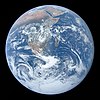 | |
| Oceans | ||
| Geology | ||
| Atmosphere | ||
| Climate | ||
| Environment | ||
| Cartography | ||
| Culture and society | ||
| Planetary science | ||
| hide | |
|---|---|































.png)
.png)
.png)
.png)


